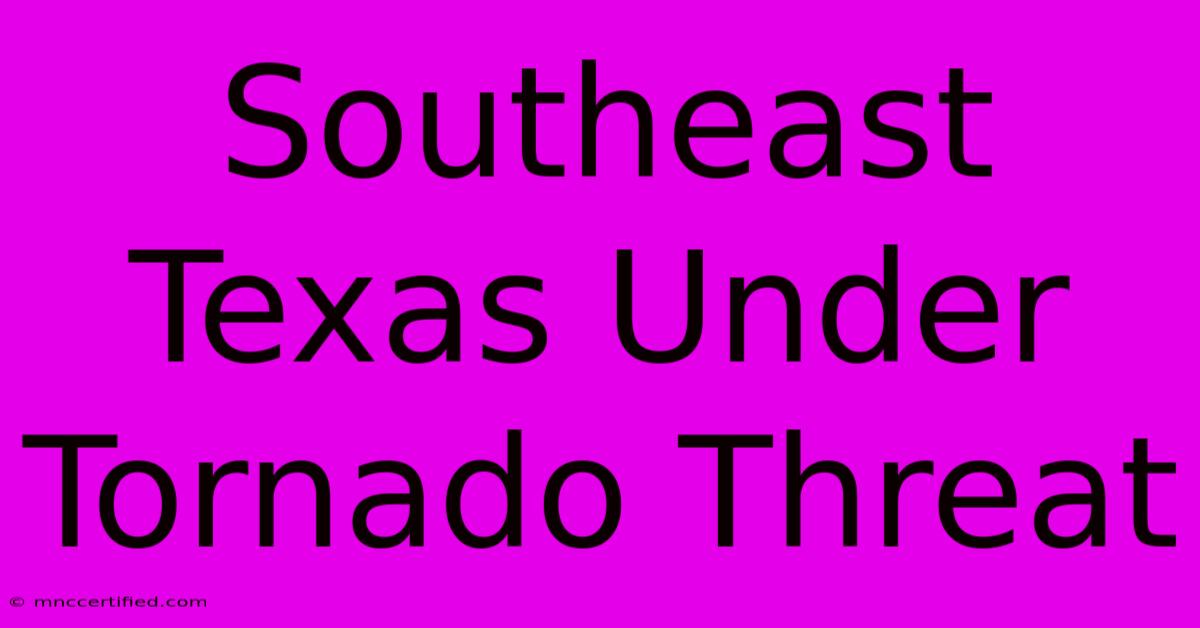Southeast Texas Under Tornado Threat

Table of Contents
Southeast Texas Under Tornado Threat: Staying Safe During Severe Weather
Southeast Texas is no stranger to severe weather, and the threat of tornadoes is a serious concern for residents. Understanding the risks, preparing adequately, and knowing how to react during a tornado warning are crucial for protecting yourself and your family. This comprehensive guide will equip you with the knowledge and resources you need to stay safe during a tornado threat in Southeast Texas.
Understanding the Risk: Why Southeast Texas is Vulnerable
Southeast Texas's geographical location and climate make it a prime target for tornadoes. The region sits at the crossroads of several weather systems, including warm, moist Gulf air and cold, dry air masses from the north. The collision of these air masses can create the unstable atmospheric conditions that fuel severe thunderstorms and tornadoes. Furthermore, the flat terrain allows for tornadoes to travel greater distances with less disruption. Knowing this heightened risk is the first step towards effective preparedness.
Historical Data & Trends
Analyzing historical tornado data for Southeast Texas reveals a pattern of significant tornado activity, particularly during the spring and early summer months. While the frequency might not be as high as in Tornado Alley, the intensity and potential for significant damage are substantial. Understanding these historical trends helps communities better allocate resources and prepare for future events.
Preparing for a Tornado: A Comprehensive Checklist
Preparation is key to surviving a tornado. Don't wait until a warning is issued; proactive measures can significantly reduce your risk.
Building a Disaster Kit: Essential Supplies
Your disaster kit should include:
- Water: One gallon per person per day for at least three days.
- Food: Non-perishable items that require no cooking or refrigeration.
- First-aid kit: Including any necessary medications.
- Flashlight and extra batteries: Avoid candles due to fire hazards.
- Battery-powered radio: To receive weather updates.
- Whistle: To signal for help.
- Dust mask: To filter contaminated air.
- Plastic sheeting and duct tape: To shelter in place.
- Moist towelettes, garbage bags, and plastic ties: For personal sanitation.
- Manual can opener: For non-perishable food items.
- Local maps: In case electronic devices fail.
Identifying Safe Rooms & Shelters
Knowing where to seek shelter during a tornado is critical. Ideally, you should have a designated safe room in your home – a basement or interior room on the lowest level, away from windows. If a safe room isn't available, an interior hallway or closet is a better alternative than an exterior room. Familiarize yourself with nearby public shelters in your community as well.
During a Tornado Warning: Actions to Take
When a tornado warning is issued for your area, immediate action is essential.
- Go to your safe room or designated shelter immediately.
- Stay away from windows.
- Get under sturdy furniture, such as a heavy table or desk.
- Cover yourself with a blanket or mattress for protection.
- Continue to monitor weather updates on your battery-powered radio.
After a Tornado: Safety and Recovery
Following a tornado, safety remains paramount. Avoid damaged areas until officials deem them safe. Be cautious of downed power lines and debris. Report any injuries or damage to the appropriate authorities. Support your community during the recovery process; teamwork is crucial in the aftermath of a disaster.
Resources for Southeast Texas Residents
Several organizations provide valuable resources and support regarding severe weather preparedness in Southeast Texas. These include the National Weather Service (NWS), the Federal Emergency Management Agency (FEMA), and local emergency management agencies. Staying informed through these channels is crucial for staying safe.
By understanding the risks, preparing adequately, and knowing how to react, you significantly increase your chances of surviving a tornado in Southeast Texas. Remember, preparedness is the best defense against severe weather.

Thank you for visiting our website wich cover about Southeast Texas Under Tornado Threat. We hope the information provided has been useful to you. Feel free to contact us if you have any questions or need further assistance. See you next time and dont miss to bookmark.
Featured Posts
-
At And T Stadium Roof Metal Piece Falls
Nov 19, 2024
-
Baby Buddha Breast Pump Insurance
Nov 19, 2024
-
Spain Edges Denmark 2 1
Nov 19, 2024
-
100 000 North Korean Troops For Russia
Nov 19, 2024
-
Woodall And Hoggle Insurance Agency
Nov 19, 2024